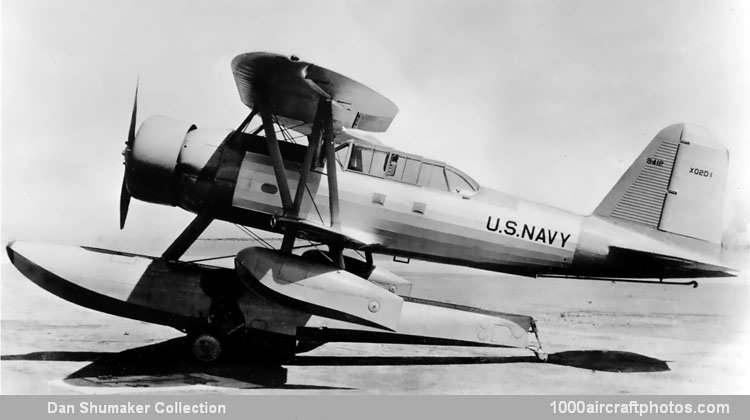07/31/2009. Remarks by Johan Visschedijk: "The two-seat XO2D-1 was the last Douglas biplane design and was to remain one of the least-known of the company's naval aircraft. Ordered in June 1933, this aircraft was powered by a 550 hp Pratt & Whitney R-1340-12 nine-cylinder air-cooled radial. The XO2D-1 was a conventional single-bay sesquiplane, with ailerons on the upper wing only and flaps beneath both wings. It was an all-metal aircraft with fabric covered center and rear fuselage, wings and control surfaces.
Intended as a standard scout-observation biplane aboard US Navy battleships, cruisers and aircraft carriers, the XO2D-1 was fitted with an amphibious landing gear with twin retractable main wheels incorporated in the central main float. For carrier operations an arrester hook was flush-mounted beneath the rear fuselage, and, for storage aboard ships, the wings could be folded manually alongside the fuselage.
The sole XO2D-1 was completed and flown at Santa Monica in late March 1934 before being shipped to NAS Anacostia, Washington, District of Columbia, where the aircraft was received on April 23, 1934. However, less than ten days after arrival, the XO2D-1 suffered substantial damage when the number three cylinder-head burned through the outside structure. Following repairs, the aircraft was returned to flight status on July 7, 1934.
Service trials were conducted by Detachment Five of Experimental Squadron One (VX1D5) at NAS Norfolk, in August and September 1934, with further tests taking place at Anacostia during the latter part of 1934 and the first two months of 1935. By that time, however, the Curtiss XO3C-1 had been found to be superior and, the Navy ordered 135 Curtiss floatplanes under the designation SOC-1 on March 23, 1935.
Five days earlier, the XO2D-1 was shipped back to Douglas which subsequently used the aircraft for limited company trials. Finally, on September 13, 1935, it was returned to the Navy at NAS North Island, San Diego. By then, though it had accumulated only 89 hours, the aircraft was in need of overhaul. Rather than incurring this additional expense, the Navy decided to survey the XO2D-1."
